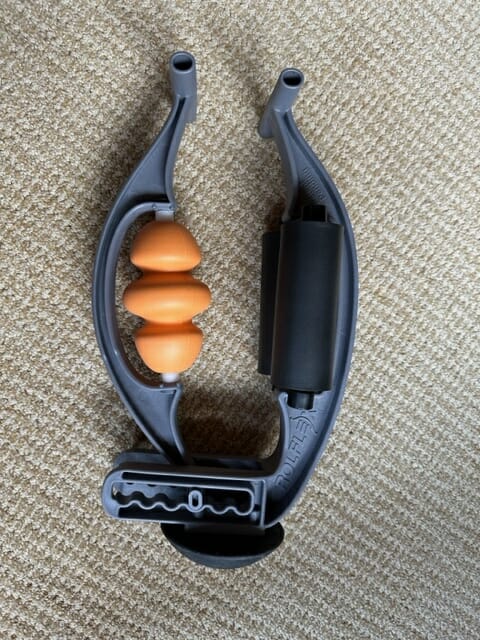
Medial and lateral epicondylitis, commonly known as “golfer’s elbow” and “tennis elbow” respectively, are both common ailments affecting the elbow.
Both conditions are really just irritations of tendons as they connect to the elbow, but both can be very painful and quite challenging to treat.
And I should know – not only am I a physical therapist, but I also happen to suffer from both conditions fairly chronically.
I’ve been dealing with elbow pain off and on for years and as a therapist, I knew how to treat myself, but my luck really changed when I came across the Rolflex.
The Rolflex basically combines the functions of a foam roller and a deep tissue massager into a single, forearm friendly device that makes it easy to release trigger points in the tight muscles of your forearms.
In terms of treatment, there’s nothing magical going on here – this is what any solid physical therapist would be doing when you see them in their clinic…
But the Rolflex let’s you treat these difficult conditions by yourself from home, which is a true game changer.
Long-story-short, I couldn’t be happier with my Roflex because in a few weeks it’s got my forearms feeling better than they have in years.
If you’re interested in the longer story, keep reading.
In this up close and personal review, I’ll go over what the Rolflex is and how it works, but I’ll also share my personal experience with the tool.
After reading, you’ll know whether or not the Rolflex is worth trying for yourself.
Medial and Lateral Epicondylitis Are a Real Pain In The…
I used to treat medial and lateral epicondylitis frequently in the outpatient clinic I worked at years ago, but I’ve been dealing with my own cases of each for a decade or so as well.
I tend to get medial epicondylitis in both elbows, but it was actually a recent flare up of lateral epicondylitis in my left elbow that inspired me to purchase the Rolflex and try it out.
When treating either condition, it helps to know what’s causing it and luckily, medial and lateral epicondylitis are really the same thing – just in a different part of the elbow.
The epicondyles refer to the part of the humerus where these different muscle groups attach: in the case of medial epicondylitis, these are the finger/wrist flexors; with lateral epicondylitis, it’s the finger/wrist extensors.
When these different muscle groups get overworked or overly tight, they put additional stress on the tendons where they meet the epicondyle, resulting in pain.
Personally, my medial elbow pain originally started when I started doing a lot of pull ups as part of my workout routine.
At first, the pain only occurred as I was finishing out my last couple sets and afterwards I was fine, so I did what any reasonable person would do – I ignored it.
Well, that didn’t exactly work out for me because soon I started feeling that elbow pain with other movements like bent over rows, bicep curls, and pretty much anything else that involved a strong grip.
The therapist in me eventually kicked in and I started stretching, icing, and avoiding painful movements and it cleared up with time.
But ever since then, a couple times a year I’d get a flare up and I’d have to repeat the whole process.
These days, I spend a lot of time typing, playing piano, and lifting weights – all of which are activities that contribute to tight forearm flexors.
I know the key to treating my problem is keeping my forearm muscles loose and strong to reduce strain on the tendons, but stretching alone isn’t preventing my problem from reoccurring.
And I’m a huge fan of trigger point release, but it’s not easy to do on your own forearm – especially when the other forearm is prone to pain too.
And this is especially true for the forearm extensors, which are located on top of your forearm…
Anyway, the key to treating either epicondylitis is reducing the repetitive strain to these tendons, so they can heal.
And the best way to do this is to reduce the tension in these muscles which occur in the form of trigger points, which are basically painful little “bunched up” areas of muscle fibers and fascia.
Stretching can help, but the best way I’ve found to release these little buggers is through manual pressure – either being held statically or with movement.
And it turns out the Rolflex can provide both.
What Is The Rolflex?
The Rolflex is a handheld massager designed specifically for use on forearms and legs.
There’s a uniquely-shaped foam roller on one side (apparently designed after the shape and size of a therapist’s thumb) and a mobile, softer foam surface on the other.
The firm therapy roller comes in 3 different densities, depending on how much pressure you want to apply to your muscles, but the real magic is in the “sandwich” design of the Rolflex’s frame.
The frame is hinged, so you can open the massager, place your forearm (or leg) inside against the therapy rollers, and then squeeze it shut to apply pressure to the muscle.
This allows you to mimic the trigger point release physical and massage therapists use to treat these conditions… it’s genius.
There are plenty of different massage sticks and rollers out there, but being able to squeeze the Rolfex with one hand makes it perfect for isolating trigger points in the forearm.
Full disclosure, I haven’t tried the Rolfex on my legs yet, but you can adjust the hinge size on the frame to fit legs too.
And the Rolflex also comes with a handle extender, so you can still squeeze the trigger points in your legs like you would with your forearm.
The handle is comfortable to hold with a single hand and the padded base makes it easy to prop against a table or your leg while sitting down.
I also appreciate that the Rolflex was developed by a physical therapist – as a therapist myself, I’m a little jealous that I didn’t think of this before.
But envy aside, this is a great idea (and I know from experience that it works) and I respect the clinician that created it.
Overall though, the Rolfex massager itself is pretty simple – with purchase you get the Rolflex with the medium-grade roller (yellow) and the handle extender.
You can also opt for the combo package that includes 2 additional rollers – the green is softest and the orange is the hardest.
I opted for the combo package, but have been using the hardest roller (orange) primarily.
Using The Rolfex To Treat Epicondylitis

The therapy roller on the Rolfex rotates, so you can use it to foam roll your forearms, which feels great by the way, or you can “floss” the muscle for more effective trigger point release.
Flossing the muscle is where you hold the pressure on the trigger point while contracting and stretching the muscle.
When working on the forearm, this could mean flexing and extending your wrist, opening and closing your hand, or supinating and pronating your wrist.
The folks behind Rolflex recommend starting out with a few reps of foam rolling the forearm muscles to warm things up and to help find those trigger points.
FYI, you’ll know you’ve found a trigger point because it will hurt when you roll over it – if it hurts, you’re in the right spot.
When you locate one of these spots, hold the therapy roller on top of it (while applying a good deal of pressure) and start moving that wrist.
Rolflex recommends doing this for 2-3 minutes at a time, 2-3x/day.
And based on my experience, I would agree this is enough to get the job done.
I like to foam roll my forearm flexors or extensors, depending on which area I’m treating at the moment, for 10 reps and then start picking out the tender spots along the muscles.
I usually find 3 different spots and perform 10 wrist flexion/extenions, 10 strong hand squeezes, and 10 supination/pronations in each spot.
It only takes a few minutes.
But be warned – if you’re doing it correctly, it’s going to hurt.
But it’s supposed to.
The pain will subside as soon as you stop and you’ll probably feel significantly looser immediately after doing this.
When my lateral epicondylitis flared up most recently, I started out with doing this 3x/day and I noticed immediate improvements.
For a little background info, I basically flared my left elbow up again doing more pull ups (I really need to improve my grip strength, that would probably help a lot) and it got to the point where my elbow hurt every time I moved it.
It was one of the worst cases of epicondylitis I had ever had.
The stretching, icing, and ibuprofen helped a little, but after a few weeks of this I wanted to try something new – and that’s when I came across the Rolflex online.
Anyway, my lateral epicondylitis was significantly better after a couple of days of using the Rolflex and after about 3 weeks, I was damn near pain free.
After a couple of weeks, I dropped down to 2x/day and now I’m using it 1-2x/day for prevention.
I’ve also started using it on my forearm flexors to prevent my medial epicondylitis from coming back and so far (knock on wood), it’s been working.
Oh, here’s a good tip – if you’re treating lateral epicondylitis, try flossing your triceps right above the elbow as well; this helped a lot when I included it in my routine.
And for medial epicondylitis, try flossing your biceps right above the elbow joint – it hurts like a mother, but I’ve found it really helpful too.
And as you’re working on loosening up these muscles, it’s a good idea to avoid any painful movements and you can ice regularly as well to help decrease inflammation around the epicondyles.
Final Thoughts
I’ve tried several massagers, rollers, and even massage guns over the years, but the Rolflex is easily the most effective self-treatment option I’ve found for epicondylitis.
The design of this massager allows you to conveniently put direct pressure on forearm trigger points by yourself and this is key to relieving pain from epicondylitis.
And personally, I couldn’t be happier with this product.
I’m trying to think of something negative to say about this massager, but nothing comes to mind – it’s affordable, easy to use, and highly effective.
And most importantly, it’s helped me get my medial/lateral epicondylitis under control.
As a physical therapist, I kinda hate to say this, but if you’re dealing with golfer’s or tennis elbow, I could see purchasing the Rolflex and trying a little self treatment before heading to the therapy clinic.
Odds are the cost of this massager is gonna be a lot less than your co-pay and this device is just as effective.
Plus, it lets you continue to keep things under control from home, something you’ll have to do after therapy is over anyway.
Because be warned, once you get either medial or lateral epicondylitis, odds are you’ll get it again in the future – believe me, I know.
Alright, well I think that’s gonna about do it.
I want to finish by saying that I’m grateful for coming across the Rolflex and I’ve been pleasantly amazed at how effective it’s been and treating my ongoing elbow problems.
So, if you’re dealing with epicondylitis, I highly recommend giving it a try.



